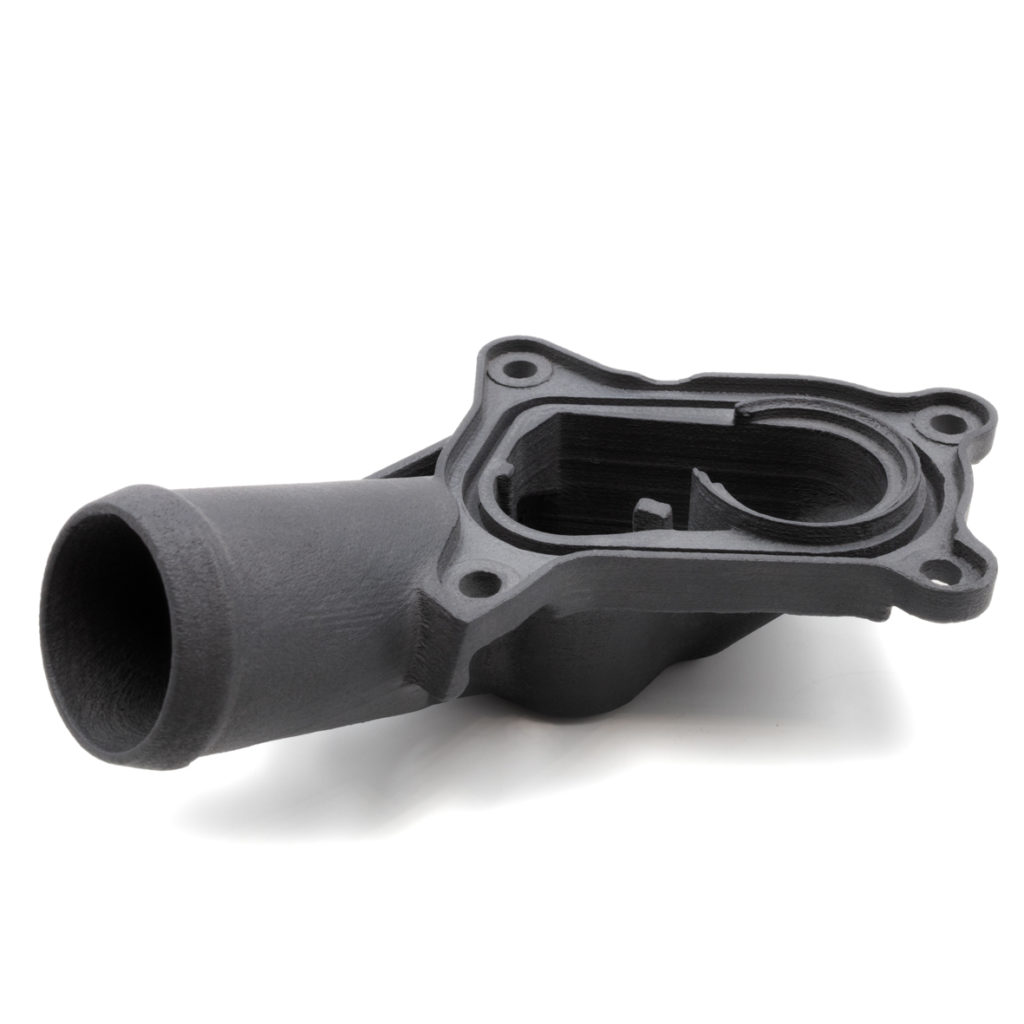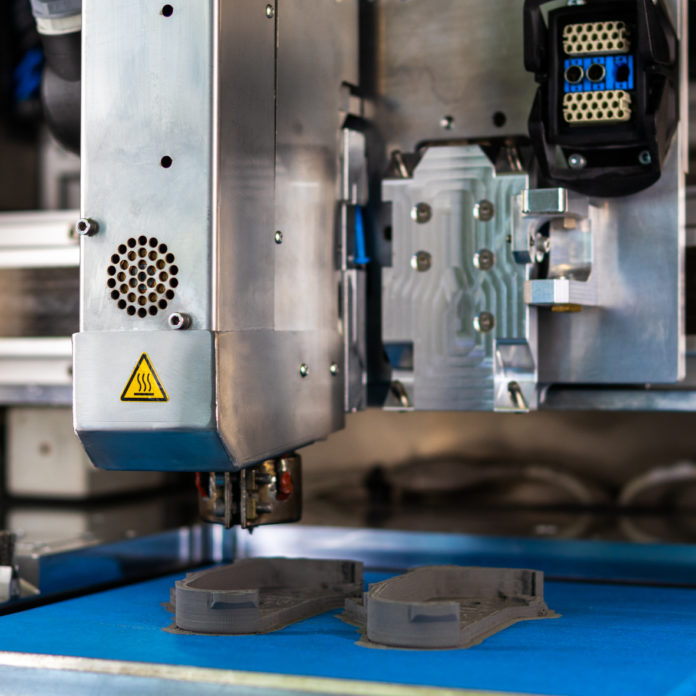All new products will be showcased at Formnext 2021 in Frankfurt
A lot is going on at AIM3D right now. The manufacturer of multi-material 3D printers recently released a new generation of print heads for the CEM process (composite extrusion modelling).
Named CEM-E2 extruder, this multi-material print head can print metal, plastic and ceramics. The company explains in a press communication that the CEM-E2 extruder’s print heads are matched to different material groups.
A version “M” (metals) print head for metal-filled materials (MIM pellets), print head “P” (plastics) for filled and unfilled plastics and print head “C” (ceramics) for higher abrasion ceramic-filled materials (CIM pellets). The new extruders/print heads are characterised by significantly improved accuracy of delivery. This enables a higher surface quality and better mechanical properties of the component. Extrusion speed has been increased by more than 200%, with manufacturing rates of up to 220 cm³/h with a 0.4 mm nozzle now possible.
Clemens Lieberwirth, CTO at AIM3D: “The material feed as well as an optional water cooling system and an improved holder for the quick-change system are all new developments. The patented CEM-E2 extruder with its parameters tailored to specific materials sets new standards in the CEM processes.”
CEM process makes the use of standard pellets possible
The appeal of CEM technology lies in the use of an additive manufacturing system for multiple materials. In addition, filaments can often be dispensed with and conventional pellets used, which offers considerable cost savings. However, the most significant benefit is the reduction in component build times through the direct use of pellets.
Development of a 3D-printed coolant manifold made of PPS GF 40 for Schaeffler

With the new CEM-E2 extruder, a component has been successfully developed made of PPS GF 40 for Schaeffler. A polyphenylene sulphide (PPS) from Celanese was used. In addition to good basic properties such as high flame retardancy, there are a large number of possibilities to tailor properties such as conductivity, thermal expansion or friction behaviour with this material.
The development partnership between AIM3D and Schaeffler set the task of developing a coolant manifold as a 3D printed component. The CEM-E2 extruder was also able to print the identical PPS and, as in the case of injection moulding, PPS GF 40 material was chosen for 3D printing. Normally, the alternative for 3D printing this component would have been a PA6 30 GF (polyamide), since glass fibre reinforced PPS in filament or powder form suitable for 3D printing is not available. The PPS material enables higher temperature characteristics and improved mechanical properties as well as potential for lightweight construction. The extremely high media resistance is also a decisive factor, as PPS absorbs hardly any water.
New approaches for the application of PPS using a CEM process
PPS GF 40 materials, which are chemically identical to the injection moulding pellets, are currently not available in filament form for 3D printing. A cost-based comparison between PPS filaments available on the market and the pellets already shows the great potential of pellet extrusion, even if the materials were available. Clemens Lieberwirth: “A direct comparison between PPS in filament and in pellet form shows there are very significant cost advantages of the pellets as well as considerably higher build rates. The manufacturing costs alone for the component (machine hours + material) are around €70, printing time is around 12 hours. Filament printers would need at least 50 hours with the same layer thickness (50 µm).” According to Lieberwirth, PPS is an interesting material for many challenging environments in the automotive and chemical industries. For example in coolant distribution systems.
PPS: a versatile, dimensionally stable, conductive and media-resistant material
PPS offers a number of properties that other plastics, but also metals, cannot achieve. The lightweight material reduces weight and thus fuel consumption and CO2 emissions, and in many areas the customer can tailor material properties such as conductivity, tribology or stability to suit their needs. Combinations of these properties, which other materials are unable to provide, are also possible. When compared to cheaper polymers, PPS exhibits higher strength and lower thermal expansion. At the same time, PPS is more resistant to water, hydrolysis and solvents as well as having clear advantages in terms of electrical and thermal insulation. Another big benefit of PPS is its “built-in” flame retardancy. PPS is inherently flame retardant, while other polymers require additives. However, these additives sometimes considerably alter mechanical properties and have the undesirable characteristic that they can be washed out by steam or aggressive cleaning agents. In addition to flame retardancy, PPS has other favourable properties without the need for any further optimisation. These include a high melting point of around 280°C, very low moisture absorption and very high chemical resistance – at room temperature PPS is impervious to all solvents. Another benefit is its thermal and electrical conductivity. By means of using additives and adjusting the dosage of these additives, electrical conductivity can be increased, making any specific volume resistance between 1 and 1015 ohms possible. Functional characteristics thus range from antistatic to conductive properties and electromagnetic shielding right up to protection against electrical discharges. This makes the material suitable for industrial instruments in environments that require explosion protection or for electronics housings that have to meet electromagnetic compatibility requirements.
Table 1: Comparison of PA6 GF 40 with PPS GF 40
| PA6 GF 30 | PPS GF 40 | |
| Continuous operation temperature | 180 °C | 210 °C |
| Glass transition temperature of melt | 49 | 90 °C |
| Melting point | 220 °C | 280 °C |
| Tensile modulus | 9,500 MPa | 14,700 MPa |
| Tensile strength | 185 MPa | 195 MPa |
| Water absorption | 8 % | 0.2 % |
Table 2: Comparison of PPS Filament with PPS GF 40 pellets
| PPS filament (unreinforced) | PPS GF 40 pellets | |
| Price/kg | €200 | €10 |
| Print rate | 35 mm/s | 150 mm/s |
AIM3D is currently developing larger pellet 3D printers in order to be able to manufacture larger parts and achieve even higher build rates.
Remember, you can post job opportunities in the AM Industry on 3D ADEPT Media free of charge or look for a job via our job board. Make sure to follow us on our social networks and subscribe to our weekly newsletter : Facebook, Twitter, LinkedIn & Instagram ! If you want to be featured in the next issue of our digital magazine or if you hear a story that needs to be heard, make sure you send it to contact@3dadept.com






